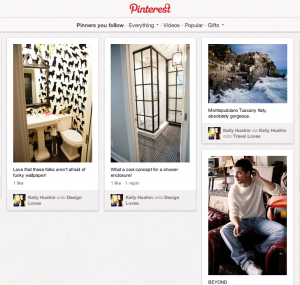by Kevin Tate
Special to the eTail Blog
Pinterest holds great promise as a discovery channel for brands, but creating an effective path to purchase is going to take some work.
Establishing an Online Path to Purchase
Today, we take the “traditional” digital path to purchase for granted. It often goes something like this:
1. A search result or display ad offers a relevant link.
2. We click-through to a tailored experience (such as a landing page, micro-site or special section of the .com site), drawing us further into the content and context around a particular product.
3. If convinced, we click through and purchase the product.
This click, convince, convert path is standard practice today, but it wasn’t always so. In the ’90s, advertisers first linked ads directly to their ecommerce pages. What they found was that – except in the case of certain impulse buys – conversion rates were lower without Step 2, “convince,” because the path to purchase typically requires a contextual bridge between the “point of discovery,” and the “point of purchase.”

Thus, “landing pages” were born, and they have persisted because they do a better job of conversion than dropping a visitor straight onto the ecommerce page.
The Social Path to Purchase – a Work in Progress
Today, marketers are challenged to find the best conversion paths for social customers. Facebook Tabs played the role of social “landing pages” for a while, but the Facebook landscape shifted, and the variety of social channels has increased dramatically – most notably through Pinterest. While Pinterest is a new opportunity, it also presents new challenges. Brands are finding that not only are conversion rates not as high as they could be, but Pinterest offers brands little control over product presentation and merchandising. Brian Solis, in defining the new “Dynamic Customer Decision Journey,” described the disconnect as follows:
To activate social commerce requires that you define an experience around the transaction where the outcome is of course the sale, but the journey is in its own way engaging and fulfilling. Here you must define a click path from a social network to a destination that facilitates a transaction but is also in alignment with the expectations of a social consumer.
When businesses do not provide a click to action path, it leads to a static or undesirable landing page that’s not optimized for social or mobile.
Given these insights and based on lessons learned from the evolution of the online path to purchase, below are three tips we can easily to establish an effective social path to purchase from products on Pinterest.
1. Use existing collections to organize your Pins
When bridging the gap between a point of discovery and a point-of-purchase, establishing product context is key. In Pinterest, that context is most often afforded through collections – groups of products that match a theme, a designer or a season.
To help establish that context and create great product experiences on the path to purchase, you should look to create pins and boards around collections and themes, rather than a potpourri of hot products.
2. Create a Social Product Showcase for your key Pinterest items
Someday, all ecommerce sites may be as socially rich and engaging as Pinterest or Facebook. Until then, the customer experience of clicking directly from a Pinterest board to your product detail page can be pretty jarring.
The best practice to address this is to create a content-centric landing page experience for a collection of products, ideally mirroring the products your customer just saw on your Pinterest board. The point is not to re-create Pinterest, but rather to bring in rich product content (videos, designer stories, details) and brand stories for the customer who just discovered your product.
This is your best chance to tell your brand and product story to a new social customer. That’s a unique opportunity that can’t be capitalized on within the confines of a Pinterest board or, in most cases, on the detail page of an ecommerce site.
3. Pay particular attention to those Pinterest-ers
The fact that Pinterest is gaining such traction – especially with such an important retail segment – is a big deal for brands. After all, comScore found that 68% of Pinterest users are women, and 1/3 of these female Pinterest users are between 25 and 44.
The role that Pinterest appears to play in product awareness and discovery represents a unique opportunity for brands to learn more about the types of customers who are participating there. Find ways to engage with Pinterest-ers and learn from them. You’ll likely find that it informs your promotional strategy, and perhaps merchandising strategy as well.
Finding the Perfect Path to Purchase
Architecting the social path to purchase isn’t going to happen overnight. As “digital marketers” turned “social marketers,” we still have a lot to learn about the interplay of brand-driven and customer-driven social spaces. If most customers are participating in social channels to “share” and going to ecommerce sites to “shop,” then it is the “shop and share” experiences we create in the middle that afford the most interesting opportunity to convert and learn about these social customers.
Kevin Tate is the CMO of ShopIgniter, a Portland, OR company that powers social retail experiences for innovative brands.




Recent Comments